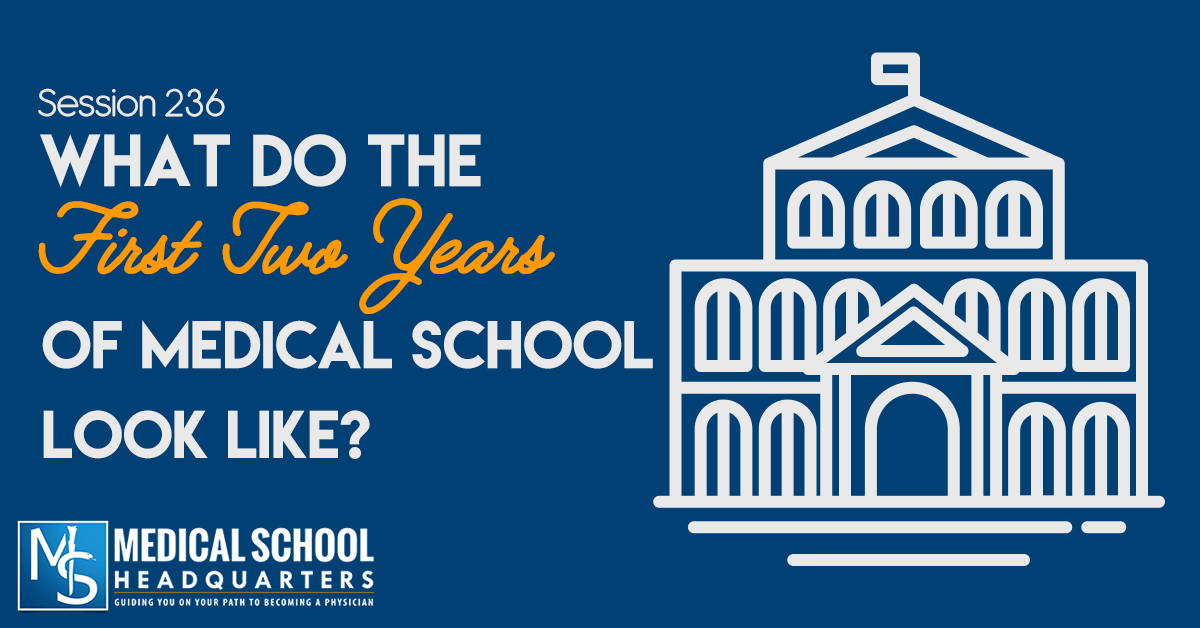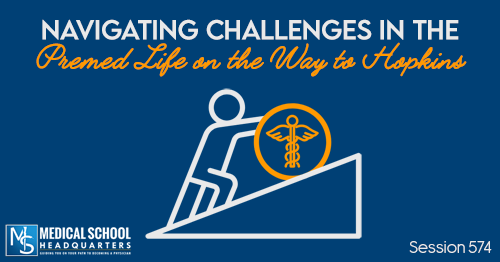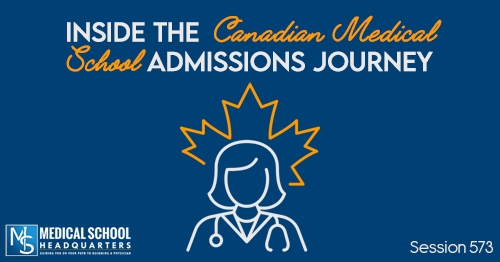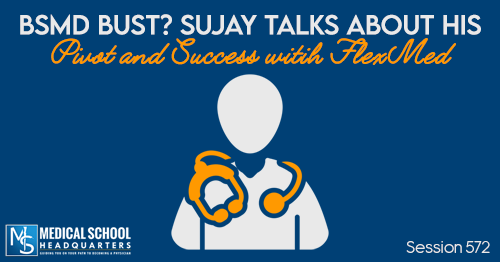Apple Podcasts | Google Podcasts

Session 236
Allison is back! The last time I did a podcast with her was back on the Specialty Stories podcast, episode 3 about Neurology. Today, Allison and I discuss our experiences during the first two years of medical school.
Recently, we got a comment on the Facebook Hangout Group asking for more information about medical school, specifically the biggest difference between M1 and M2, which are your first two years of medical school. This student wanted to know about the schedules, breaks, etc. It’s a hard answer because every school is going to be different.
So Allison and I are going to share our personal experiences along with some variability in there as well about what we know from other schools that we applied too or looked at or what we hear nowadays.
Listen to this podcast episode with the player above, or keep reading for the highlights and takeaway points.
[03:55] The First Year of Medical School: Drinking From a Fire Hose
Allison describes her first year of medical school as pretty crazy, but she liked it. She always liked school. You’re wanting so badly to get to medical school so how can you not be thrilled and excited. So there’s a lot of anticipation and excitement when you first start.
I wasn’t as excited when I started, well, because as Allison points it out, I hadn’t been studying for three years and I’ve been working. Plus, I was scared. And mad actually because it had nothing to do with orthopedics. In fact, the only class I liked in my first two years was Anatomy.
Allison thinks it’s all about a change in mindset especially when you’re going from working into studying and you’ve forgotten how to study. Allison took a year off but she also had a very different undergrad experience than a lot of people. She was at McGill, the Harvard of Canada, and there was a lot of studying, but Allison didn’t have a traditional university experience.
Allison wasn’t going to parties and drinking. She was literally studying. She studied all the time so she was really well-prepared for that aspect. It was more of the pace that was different because of how much you had to study and how much material you had to shove into your brain at a given time. It was just like med school.
Allison says it was the pure amount of material that was like whoa! And the labs. It’s generally what first year is—classes and lab, being in the library or wherever you choose to study.
It was the sheer amount of material that was like 'whoa!'Click To Tweet[07:00] The Immersive Experience in the First Two Years of Medical School
Allison says she started to feel like people who weren’t going through what we were going through couldn’t really understand how much pressure we were under and how challenging it was.
I started to feel like non-medical students couldn't really understand how much pressure I was under.Click To TweetIt’s the same for undergrads too. Non-premed students don’t understand the pressures that you’re going through as a premed—the commitment and time you need to put in to study because you have to get good grades.
How Relationships Change in the First Two Years of Medical School
Allison recalls going out to eat ribs after we dissected some ribs or talking about poop after dinner and normal people don’t do that. So it was just different. That’s why a lot of relationships fall apart at the beginning of med school.
People you’ve come into med school dating who are not in medicine and that starts to fray a lot of times since you’re now immersed with a group of people you’re literally doing everything with.
In med school, you become so close to those in your class because you're spending so much time with them studying.Click To TweetOn the other hand, other relationships also start, so a lot of people pair off at the beginning of med school. In med school, you become so close to those in your class because you’re spending so much time with them studying. The first year of medical school is an immersion.
[Related episode: How Relationships Change in Medical School.]
[09:40] Systems-Based Learning versus Traditional Learning in the Preclinical Years
The traditional style of learning is where you take your first year anatomy, histology, the nervous system, physiology, etc. In your second year, you take pathology and pharmacology. You learn everything about healthy first and then everything pathologic and unhealthy on your second year.
In systems-based learning, you study the kidney. You study the anatomy of normal kidney and the physiology of the kidney and the pharmacology of the kidney. Then you study pathology and anything that goes wrong with the kidney. Arguably, systems-based learning is better because everything is integrated.
Pharmacology, specifically, is very challenging because it’s memorization and it’s not systematized. You learn classes of drugs but if you applied that to a system, like an organ system, it would be probably have been a lot more straightforward and not easy to memorize.
[11:25] Problem-Based Learning in the First Two Years of Medical School
You can have problem-based learning in both the traditional and a systems-based medical school curricula. Problem-based learning is a small group discussion, learning about everything surrounding a particular problem. The faculty creates a patient for you and gives you a huge history then you sit down and discuss it with a facilitator.
This is one of the things that I help teach at the University of Colorado. I haven’t actually done one yet. I’m on the substitution list for the problem-based curriculum. But we had a little bit of that at New York Medical, specifically around pathology although it was different.
You can have problem-based learning in both the traditional and systems-based curricula.Click To TweetPersonally, I would have liked a systems-based, problem-based learning system. With problem-based learning, you start thinking clinically right from the get-go. They start giving you cases so it’s very useful and very helpful.
Nevertheless, Allison knew systems-based learning existed in some schools. But her consideration for choosing her school primarily was geography.
Allison’s advice to students is that if you’ve been accepted to multiple schools, take the time to actually go through and see what their curriculum is because it could affect you depending on the kind of learner you are. Although for most people, they just want to be a medical student anywhere.
[13:10] Patient Interaction in the First Two Years of Med School
Most medical schools nowadays will throw you into seeing patients right away. We went to clinic and each of us had a preceptor assigned to us. Allison had her preceptor in Winchester county who is a primary care physician. She went to his office once a week and she would shadow them. At some point, he would have her see a couple of patients on her own first and then tell them what’s going on.
We didn’t have many standardized patients. In fact, I tell students at the University of Colorado where I help them with their communication with standardized patients that they’re so lucky to be involved with standardized patients so early because it was something we didn’t have at New York Med.
We didn’t have the immediate coaching of talking to standardized patients. Allison and I actually didn’t do it until the second year. We did the OSCE prep and then the OSCE. That’s where you learn the physical examination.
So that’s common in almost every school now and it’s almost a sales pitch some schools have now where they get students involved right away with patient care and so do most schools these days.
When I do mock interview with students, one of the things I ask is why you’re interested in this particular school and their usual answer would be early patient care, etc. But getting early patient interaction is not unique for medical school these days.
It's almost a sales pitch some medical schools have now where they get you involved right away with patient care.Click To Tweet[15:22] Mandatory Lectures in the Preclinical Years
Some schools have mandatory lectures and some schools don’t. Allison learned in college that sometimes when she would miss class and just teach herself from a textbook that she often learned more. For instance, her general chemistry class lectures were really useless. She would go to them but found them entirely useless and found that the T.A. sessions were much more useful.
Allison started off going to lectures in medical school and at some point, she realized she wasn't getting good value for her time.Click To TweetAllison started off going to lectures in medical school and at some point, she realized she wasn’t getting good value. Hearing it and taking notes, she felt it was an inefficient way to learn. Instead, she would have scribes.
Scribes are people who take notes on the lectures and they would distribute it and you would pay. Then you would just have the transcript of the lecture so she could use that and read that, take notes on it, and go from the textbook.
Is Attending Lecture Worth It in the First Two Years of Medical School?
Allison found it much more efficient not to go to lecture. She admits she wouldn’t go to a lot of classes, especially in second year, she says she rarely ever went to lecture since it just was not a good way for her to learn. Obviously, she went to all of their labs and all small group sessions but she found that she just learned very well on her own.
I, on the other hand, would just meet up with Allison to study. She’s doing well and she knows how to study, so I was just doing what she was doing. We were like two peas in a pod, as Allison would describe it. We would get up early and go to a place where we could study all day long.
In second year, Allison recalls that time when we had to read this large textbook from cover to cover, and we would just sit there for hours and hours. We would be studying and taking notes from the textbook. It worked a lot better for her than for me, however.
[17:50] Learning Styles: How Will You Best Learn in Med School?
So this is one of the things where I talk about learning styles and needing to adjust study styles and techniques to not only for yourself going from high school to college and then college to medical school, but also between students.
Allison and I started dating very early on in medical school, and so we studied all the time together. I never took into account the fact that I didn’t learn the way that Allison learned. I just wanted to hang out with her, so we’d go hang out and study. And that reflected in my performance. I should have gone to the lectures. It was inefficient studying for me because I’m a very auditory learner.
So there are some people that needed to be in class to get that auditory feedback and that style of learning like me, while there are other people like Allison who just learned a lot better in a different way. Therefore, it’s very important very early on to figure out what kind of learner you are and how best to study and how best you’re going to learn the information.
It's very important to figure out what kind of learner you are and how you study best.Click To Tweet[Related episode: Building Better Study Skills for the Sciences and MCAT.]
[20:40] Summer Break Between the First and Second Years of Medical School
Specific to New York Med, between first and second year, we had the last break of our life. Allison spent her summer shadowing and that’s when she found out she wanted to do Neurology. I, meanwhile, stayed in the city and was helping out a free clinic and got scholarship stipends.
Most schools are still going to have that break between first and second year. Although I have heard there are some schools that are getting rid of that break and are going into an eighteen-month first and second year, basically eighteen months to pack in all of those two years and they start clinical rotations much earlier.
So look into the school you’re applying to and see what they have and whether they’re going to have a summer break. Allison adds we should put “break” because if you’re going into something really competitive like you know you want to do a certain specialty, you’re probably going to want to use that “break” to start research and hook up with a mentor, etc.
So it’s not like you’re really using that “break” to have a break, but you can use it to go shadowing and keeping busy. In theory, you could use it to hang out, but for most people, they use that time to further their career.
[23:03] The Second Year of Medical School and Studying for Step 1
Second year was basically the same as first year, just different courses and different classes. Another thing that’s different is you start getting more in-depth with the physical exam. We had standardized patients, people that you can kind of learn the exam on, which was a really interesting part of second year.
We would go to a clinic on one Saturday and we learned the breast exam, the rectal exam, and general exam for women and men. Allison describes it as a very different type of experience which was something very unique.
What Allison liked about second year was feeling much closer to being a doctor, not based on time but once you get to pathology, you start to talk about disease, so you’re really starting to get into more of learning about actual disease, which is what you need to know a lot about when you become a doctor. As opposed to a systems-based class, you would be studying it all along.
Step 1: The Light at the End of the Tunnel
Basically, Step 1 is that light at the end of the tunnel. Studying for it was like five to six weeks beforehand. We finished the classes in May and we took the exam at the end of June. We had about five to six weeks of studying essentially all of our first and second year. There specific books to help you with that. You can also listen to our Board Rounds podcast to help you prepare for Step 1.
Once you finish Step 1, then you’re right into third year and there’s no more break. Once you go straight into third year then you’re on the wards. You’re finally like a real doctor. You finally get to wear your white coat around and wear scrubs all the time. It was an exciting time.
Reminder: Do not advertise you’re a doctor or a medical student by putting anything in/on your car. People have gotten their cars broken into because people were looking for drugs.
[27:24] Becoming a Professional Test Taker in Medical School
Exams were very frequent like every two weeks. Some medical schools have exams every week now. You end up becoming a professional test taker. since you take so many exams. Anatomy has four big ones and then a big final. Histology has four big exams too. It ended up being spliced out so you’re having exams essentially every week or every two weeks. There are so many tests and they’re so frequent.
You end up becoming a professional test taker in medical school.Click To TweetHow to Focus While Studying in Medical School
One of the biggest issues with studying right now for everybody is probably your phone and social media. The data shows that it takes about 20 minutes to get back into the groove and the mindset of where you were before that interruption happened.
So if you check your phone every half an hour or you get a text message from your loved one every hour or so, you are wasting so much time. My best advice is to put your phone in airplane mode and study. Then every hour or so, pick your head up and take a little break and then get back to work.
The data shows that it takes about 20 minutes to get back into the groove of your work after getting interrupted.Click To Tweet[Related episode: How to Easily Improve Your Test Scores & Learning Skills.]
[32:05] Use of Your Free Time in Medical School and Last Words of Wisdom
Sleep when you have a little bit of free time like when you finish exams. We would treat ourselves when we were done with an exam.
I would have like a day, usually a weekend, where we would binge-watch episodes of 24 and CSI. Basically, television was a big thing for us. We were either studying or watching TV.
We also had an end-of-the-year party, med school prom, and another party at the end of second year, and another party at the end of fourth year. There were lots of work but there were also lots of fun. But only have fun once in awhile.
Don't lose track of friends and family as a medical student.Click To TweetLastly, don’t lose track of friends and family because that’s very important. You need to take care of yourself. Eat healthily and make time for exercise.
Links and Other Resources
- Check out my Premed Playbook series of books (available on Amazon), with installments on the personal statement, the medical school interview, and the MCAT.
- Related episode: Welcome to Your Third Year of Medical School.
- Related episode: Top 7 Things You Should Know as a Medical Student.
- Need MCAT Prep? Save on tutoring, classes, and full-length practice tests by using promo code “MSHQ” at Blueprint MCAT (formerly Next Step Test Prep)!











